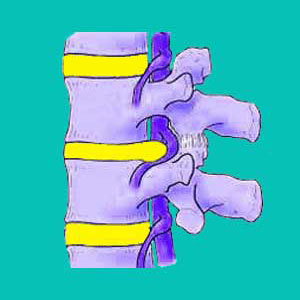
Discogram testing is utilized in an attempt to determine if a specific intervertebral structure is involved in a painful back or neck complaint. Discography studies have lost much of their popularity in the past 20 years, since there is little to be gained and much risk to manage. Many doctors have simply stopped using the test due to several reasons, including the discomfort it entails for the limited diagnostic information potentially gained. However, other care providers embrace discography and continue to use it on virtually all their back and neck pain patients, as it is a great way for them to make extra money and we all know how the business side of medicine has become the predominant guiding factor in patient care.
Discography is a dangerous technique in which a needle is introduced directly into one or more spinal discs and fluid is subsequently injected into the disc tissue. The idea behind discography is to increase the mass of the nucleus and swell the disc with the addition of fluid. This is theorized to help determine if the disc is the root source of an existing back or neck pain complaint. When the disc is fluid-enriched, it will swell and theoretically put more pressure on whatever nerve structure it is already impinging upon, supposedly increasing the degree of pain temporarily.
Furthermore, since the fluid injected also contains a special dye that can be imaged using x-ray technology, the disc can be visualized and inspected for dye migration that might indicate a rupture in the annulus fibrosus and the possible existence of a chemical radiculitis condition.
We have already provided a comprehensive overview of spinal discography in a past article, but this new essay focuses on the many risks inherent to discography evaluation.
Discogram Health Risks
There are several distinct general health risks that are involved in discogram testing. These factors can act alone or in combination to cause injury to the spinal structures or negatively influence the overall wellness of the patient:
Discography can cause spinal infection in the disc itself (known as discitis) or within the larger spinal anatomy. Discography has been linked to cases of meningitis and subsequent patient death.
Discography can create holes or tears in the annulus fibrosus that might not heal. Some patients with minor bulging discs are subjected to discography and suffer serious intervertebral ruptures, extrusions and/or sequestrations.
The invasive nature of discography makes it possible to damage nerve tissues, the spinal cord, circulatory structures or other sensitive structures in the spinal anatomy. Injury to the meninges might create spinal fluid leaks that may require surgical intervention to resolve.
Disc Evaluation Diagnostic Risks
There are risks of discography that can affect the accuracy of the diagnostic process for the worse. In fact, discography is a direct cause of misdiagnosed herniated discs in many affected patients:
Discogram testing is known to be incredibly painful, even in patients who have normal discs that are obviously not the source of any pain. The patient’s citation of pain is often used to justify the conclusion that the injected disc is indeed the sole or primary cause of existing pain, which is often a highly incorrect assumption.
Regardless of whether exacerbated pain is present upon injection or not, the dye is often used to diagnose existing annular tears or ruptured disc conditions which are then implicated as being the sole or primary cause of pain. There is no research data that proves that either of these conditions is inherently painful, so this assumption is highly subjective and most often incorrect.
Finally, there are often other nearby residing causes of spinal or foraminal stenosis that are doing the majority of harm and primarily causing the painful complaint. However, since stenosis of the central or foraminal canals already exists due to arthritic or ligamentous concerns, adding fluid into the disc will close off the canal even further. The symptoms will increase and the disc will be blamed, although in these cases it is merely a coincidental or minor factor in the symptom-generation process that was induced exclusively by the injection itself.
Discography Mindbody Risks
The negative factors associated with discogram testing do not stop with physical and diagnostic influences. In fact, the test can also have a direct negative effect on the psychoemotional state of the individual through the power of the nocebo effect and therefore can also have the following wide-ranging consequences of the health of the patient:
If the patient is told that they have a bad disc that is their source of pain, they might be permanently damaged by the nocebo effect of the diagnosis and feel that their anatomy has failed them, despite the disc being normal in its degeneration. It is well known that the psychoemotional state of the patient can cause pain, worsen existing pain or perpetuate pain past its organic timeline. If the patient is told they have a purely structural reason for the pain to exist, clinical data suggests that the patient will continue to experience pain based on mindbody factors, even if the disc diagnosis is incorrect.
Discogram Warnings
We caution all patients who have been recommended to undergo discography testing to consider their path carefully. The test is likely to be very painful and may produce absolutely no objective diagnostic conclusions. Any conclusions that are likely to be reached are purely subjective and might be used to convince the patients towards more expensive, dangerous and invasive treatment options, such as herniated disc surgery.
We recommend getting several opinions from a variety of caregivers before agreeing to undergo the test. We also highly recommend doing lots of independent research to fully understand the risk/benefit ratio of discogram evaluation. In our experience, we have spoken to very few patients over the past 10 years who actually received any true value from discography testing. Most simply were tortured and a significant number experienced lingering pain or discomfort of a much more severe nature days, weeks or even months after the procedure. Think carefully before walking this same path of misery.
There are rare circumstances where discography can be a valuable part of the diagnostic process. However, these cases are highly case-specific and do not represent the majority of cases where the test is typically recommended or utilized.





